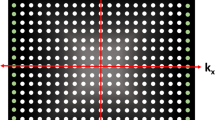Abstract
The data of magnetic resonance imaging (MRI) studies include not only grayscale images, but also textual information associated with them —personal data about the patient, parameters of scanning and data processing, etc. This information is stored separately from graphic images. Therefore, the possibility for its correction and loss cannot be excluded. In this paper, the method of generation of marker information on diagnostic images is described. The marker information, as a textual analogue, is entered on the image during an MRI scan and becomes an integral part of the diagnostic material along with the images of anatomical structures. The method is realized by using the selective radiofrequency presaturation of non-scanable slices oriented perpendicularly to the scanned slices. It leads to the formation of bands of reduced signal in the areas of intersections of these slices on images. In this case, the band thicknesses are equal to the thicknesses of non-scanable slices. Different combinations of these bands (marker lines) are formed directly on images and can contain information about MRI studies. This information is determined not only by positions and angle orientations of bands, but also by their thickness, total brightness and brightness distribution in the transverse direction of these bands. The examples of introducing and positioning the marker information in conventional MRI studies are presented.







Similar content being viewed by others
References
Bruker data format (MRC cognition and brain sciences unit) (2013), http://imaging.mrc-cbu.cam.ac.uk/imaging/FormatBruker. Accessed 11 Sept 2017
DICOM Digital Imaging and Communication in Medicine (2011), http://dicom.nema.org. Accessed 11 Sept 2017
R.R. Edelman, D.J. Atkinson, M.S. Silver, F.L. Loaiza, W.S. Warren, Radiology 166(1), 231 (1988)
M. Miyazaki, V.S. Lee, Radiology 248(1), 20 (2008)
A.N. Garroway, P.K. Grannell, P. Mansfield, J. Phys. C Solid State Phys. 7, L457 (1974)
C.M. Collins, Z. Wang, Magn. Reson. Med. 65, 1470 (2011)
Author information
Authors and Affiliations
Corresponding author
Rights and permissions
About this article
Cite this article
Anisimov, N.V., Pavlova, O.S. Encoding Textual Information in Magnetic Resonance Imaging. Appl Magn Reson 49, 165–174 (2018). https://doi.org/10.1007/s00723-017-0944-3
Received:
Revised:
Published:
Issue Date:
DOI: https://doi.org/10.1007/s00723-017-0944-3




